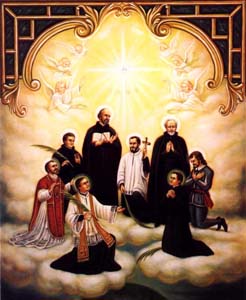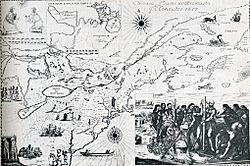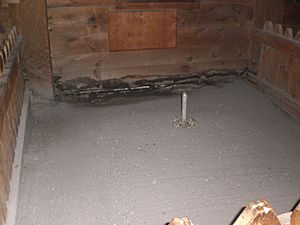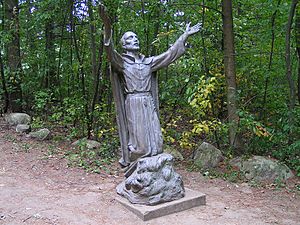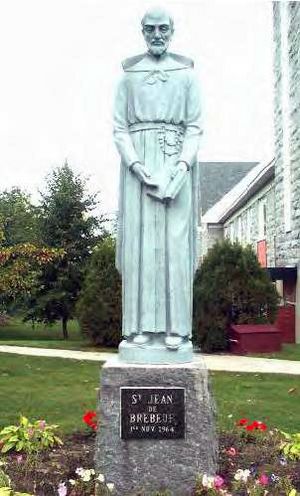Jean de Brébeuf facts for kids
Quick facts for kids SaintJean de Brébeuf S.J. |
|
|---|---|
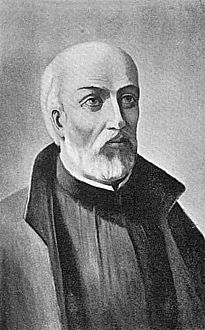 |
|
| Martyr; Apostle of the Hurons | |
| Born | 25 March 1593 Condé-sur-Vire, Normandy, France |
| Died | 16 March 1649 (aged 55) Huron village of St. Ignace, near Sainte-Marie among the Hurons, near Midland, Ontario, Canada |
| Venerated in | Catholic Church, Anglican Communion |
| Beatified | June 12 1925 |
| Canonized | 29 June 1930, Canada by Pope Pius XI |
| Major shrine | Martyrs' Shrine, Midland, Ontario, Canada |
| Feast | 16 March, 26 September (Canada, also United States in General Roman Calendar 1962), 19 October (United States and elsewhere) |
| Attributes | Pyx |
| Patronage | Canada |
Jean de Brébeuf (born March 25, 1593 – died March 16, 1649) was a French Jesuit missionary. He traveled to New France (which is now Canada) in 1625. He spent most of his life working with the Huron people there. He learned their language and culture. He also wrote many notes about them to help other missionaries.
In 1649, Brébeuf and another missionary were captured. This happened when Iroquois warriors attacked a Huron village called St. Louis. The missionaries and Huron captives were killed on March 16, 1649. Brébeuf was later declared "blessed" (beatified) in 1925. He was one of eight Jesuit missionaries made saints in the Catholic Church in 1930.
Contents
Jean de Brébeuf's Life Story
Early Years and Education
Jean de Brébeuf was born on March 25, 1593, in Condé-sur-Vire, Normandy, France. He joined the Society of Jesus (Jesuits) in 1617 when he was 24. He spent two years learning from Lancelot Marin. From 1619 to 1621, he taught at the college in Rouen.
Brébeuf almost had to leave the Jesuits in 1620. He caught tuberculosis, a serious illness. This sickness made it hard for him to study and teach for the usual time. Even though he wasn't a top student, Brébeuf was good at learning languages. Later in New France, he would teach Native American languages to other missionaries and French traders. He became a priest in February 1622.
Becoming a Missionary
After teaching for three years, Brébeuf was chosen to go on missions to New France. In June 1625, Brébeuf arrived in Québec. He came with other priests, Fathers Charles Lalemant and Énemond Massé.
For about five months, Brébeuf lived with the Montagnais tribe. They spoke an Algonquian language. In 1626, he was sent to work with the Huron people. The Huron spoke an Iroquoian language. Brébeuf lived mostly as a missionary to the Huron from then on.
He briefly lived with the Bear Tribe at Toanché. However, he did not succeed in converting them to Catholicism. He was called back to Québec because the English were a danger to the whole colony. He reached Québec on July 17, 1628. On July 19, 1629, Samuel de Champlain surrendered to the English. The missionaries then had to return to France.
In France, Brébeuf worked as a preacher and confessor in Rouen. He took his final Jesuit vows in 1630. From 1631 to 1633, he worked at a college in Eu, Seine-Maritime. He returned to New France in 1633. He lived and worked there for the rest of his life.
Brébeuf, along with Antoine Daniel and Ambroise Davost, chose Ihonatiria as their main mission center. This was a Huron village. At this time, many Huron people got sick from new diseases brought by Europeans. These diseases were common in Europe, but the Huron had no immunity to them. Many Huron people died. They blamed the Europeans for the deaths, but no one understood why so many were dying.
The Huron called Brébeuf Échon. He spent a lot of time teaching and talking with his Huron friends. This helped him learn a lot about their culture and spiritual beliefs. He learned their language and taught it to other missionaries and settlers. Other Jesuits said he was good at adapting to the Huron way of life.
Brébeuf tried to find links between the Huron religion and Christianity. He hoped this would make it easier to convert the Huron. The Huron knew Brébeuf for his skills, especially in making rain. But he thought their spiritual beliefs were "foolish." He was determined to convert them to Christianity. Many Huron people did not like Brébeuf. Some believed he was a sorcerer.
By 1640, almost half of the Huron people had died from smallpox. This caused big problems in their society. Many children and older people died. As their loved ones died, some Huron started to listen to the Jesuits. The missionaries did not get sick, so they seemed to have great power.
Brébeuf's work to convert people was slow at first. By 1635, some Huron agreed to be baptized. He said he had 14 converts by 1635, and 86 by the next year. In 1636, he wrote a detailed report about The Huron Feast of the Dead. This was a big ceremony where people reburied the bones of their loved ones. It happened when a village moved to a new location.
In 1638, Brébeuf gave control of the mission at Saint-Joseph I to Jérôme Lalemant. Brébeuf then became the leader of his new mission, Saint-Joseph II. In 1640, Brébeuf broke his collarbone during a mission. He was sent to Québec to get better. There, he worked as a mission helper. He taught the Huron and advised the Ursulines and Religious Hospitallers. On Sundays, he preached to the French settlers.
Brébeuf is known for writing the "Huron Carol" around 1642. This is Canada's oldest Christmas song. He wrote the words in the native language of the Huron people. The song's tune comes from an old French folk song.
Learning the Huron Language
The Jesuits were trained to learn new languages. Brébeuf was very good at languages. This was one reason he was chosen for the Huron mission in 1626. He worked hard to learn the Huron language. He was known for mastering the Native speaking style. This style used metaphor, long descriptions, and repetition.
Brébeuf knew that understanding the language was key to sharing complex religious ideas. He believed learning native languages was very important for the Jesuit missions. He also noted that it was a very hard task. He felt his main goal in his early years in New France was to learn the language.
As he got better at the Wyandot language, Brébeuf felt more hopeful about his mission. By understanding Huron beliefs, he could explain Christian ideas. He knew the people would not give up all their old beliefs.
Brébeuf worked hard to write down what he learned for other missionaries. He built on earlier work by other priests. He made big improvements in how sounds were written. He found that Huron used compound words. This was a major discovery for language study. It became the basis for all later Jesuit language work.
He translated a catechism (a book of religious teachings) from French into Huron. This was the first printed text in that language. He also made a dictionary of Huron words. He focused on translating religious phrases, like prayers and parts of the Bible.
His Death and Legacy
Brébeuf was killed at St. Ignace in Huronia on March 16, 1649. He and Gabriel Lalemant were captured when the Iroquois destroyed the Huron mission village at Saint-Louis. The Iroquois took the priests to another village. There, they killed the missionaries and Native converts.
Other Jesuit priests had also been killed in earlier raids. The Jesuits saw these deaths as proof that their mission to the Native Americans was blessed by God. They believed it would be successful.
During his capture, Brébeuf was said to be more worried about the other Jesuits and the Huron captives than himself. Two Jesuits, Christophe Regnault and Paul Ragueneau, wrote about the deaths of Brébeuf and Lalement. They learned about the events from Huron people who escaped. Regnault saw the bodies to check the stories. The Jesuit accounts say Brébeuf suffered without complaining. This showed his strong faith.
Jesuit missionaries knew they faced harsh conditions and dangers. They expected to die for their faith. They believed this missionary life was a chance to save others and themselves.
Relics and Sainthood
Fathers Brébeuf and Lalement were found and buried together. Brébeuf's remains became important religious objects in New France. Many believed his death was like the death of Christ. This made his story even more meaningful. In 1649, Brébeuf's bones were prepared to be moved to Québec for safekeeping.
Brébeuf's family later gave his skull to Catholic churches in Québec. It was kept by nuns until 1925. Then, it was moved for a ceremony to celebrate Brébeuf being declared "blessed." Catholics believe these relics connect them to the saint.
In 1652, Paul Raguenau gathered writings about the martyrs of New France. He put them into a document to start the process of making them saints. This document was called Memoires touchant la mort et les vertus (des Pères Jesuits). Religious groups in New France saw these Jesuit martyrs as following in the footsteps of earlier saints. This helped the idea that "Canada was a land of saints."
Jean de Brébeuf was made a saint by Pope Pius XI on June 29, 1930. He was named one of the patron saints of Canada by Pope Pius XII on October 16, 1940. A newspaper at the time called Brébeuf the "Ajax of the mission." It described him as a strong man of noble birth.
Modern Connections
It is said that Brébeuf gave the modern name to the sport of lacrosse. He thought the sticks used in the game looked like a bishop's crosier (crosse in French).
He is buried at the Church of St. Joseph. This church is part of the rebuilt Jesuit mission of Sainte-Marie among the Hurons. This site is near Midland, Ontario. A plaque found near his grave in 1954 reads: "P. Jean de Brébeuf /brusle par les Iroquois /le 17 de mars l'an/1649" (Father Jean de Brébeuf, burned by the Iroquois, March 17, 1652).
In September 1984, Pope John Paul II prayed over Brébeuf's skull. He then joined a large outdoor service at the nearby Martyrs' Shrine. About 75,000 people attended this service. It mixed Native traditions with Catholic prayers.
Many schools are named in his honor:
- St. Jean Brebeuf School in Calgary, Alberta
- St. John Brebeuf Regional Secondary School in Abbotsford, British Columbia
- St. John Brebeuf School in Winnipeg, Manitoba
- Brébeuf College School in Toronto, Ontario
- St. Jean de Brébeuf Catholic Secondary School in Hamilton, Ontario
- St. Jean de Brebeuf Catholic High School in Vaughan, Ontario
- St. Jean Brebeuf Catholic School in Brampton, Ontario
- St. John Brebeuf Catholic School in Erin, Ontario
- Collège Jean-de-Brébeuf in Montreal, Quebec
- École Jean-de-Brébeuf in Gatineau, Québec
- Brebeuf Jesuit Preparatory School in Indianapolis, Indiana
There is also a church, Eglise St-Jean de Brebeuf, in Greater Sudbury, Ontario. A St. John Brebeuf Catholic Parish is in Niles, Illinois, USA. A unit at Camp Ondessonk in the Shawnee National Forest is also named after him. This Catholic camp is named for all the North American Martyrs.
The town of Brébeuf, Quebec, is named after him. So is rue de Brébeuf in Montreal. Parc Brébeuf in Gatineau, Quebec, also honors him and has a statue.
Jean de Brébeuf is a character in the 2013 novel The Orenda by Joseph Boyden. He is also the subject of Brébeuf and his Brethren, a long poem by Canadian poet E. J. Pratt.
See also
 In Spanish: Juan de Brébeuf para niños
In Spanish: Juan de Brébeuf para niños


